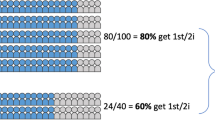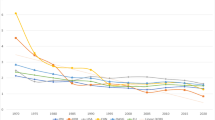Abstract
Increasing reliance on market mechanisms in higher education is analysed both as one of the approaches to steering as well as in relation to the consequences of markets for quality and accessibility of higher education. This article goes beyond the normative considerations of market elements as inherently good or bad and the economic theory-guided focus on freedoms of users and providers, by presenting an alternative conceptualization. The conceptualization adapted from studies of markets in other parts of the welfare state to the context of higher education is based on two dimensions: (1) who effectively controls production of certain goods and services and (2) how access to and funding of these goods and services are regulated. It focuses on interests of three main actors—the state, the users (students) and the providers (higher education institutions). This leads to six conceptually distinct markets, whose key characteristics are illustrated by examples from Denmark, England, India, Norway, Portugal and Serbia. The key message is that this alternative conceptualization allows identifying variance in marketization of higher education with regards to (1) which actors are empowered, (2) who are the likely winners and losers and (3) what might be the risks of introducing specific market elements in a higher education system. More generally, a more nuanced analysis relying on this conceptualization can potentially contribute to a deeper understanding of political and policy dynamics in higher education.
Similar content being viewed by others
Notes
As demonstrated, in student protest at the University of Amsterdam and the London School of Economics in February/March 2015.
Gingrich uses the terms ‘producers’ and ‘consumers’. Given that in higher education one can only speak of ‘quasi-markets’ and higher education cannot be characterized as a pure private good (Marginson 2011), the more appropriate terms (used in this article) are ‘providers’ and ‘users’.
For principal-agent theory, see Laffont and Martimort (2002). The theory of incentives: the principal-agent model, Princeton (N.J.): Princeton University Press.
The term austerity is not linked to its conventional understanding of economic policies aimed at cutting public expenditures, but rather describes a situation where costs for services are not (entirely) funded through the public purse but (partly) privatized, no matter whether this is due to budgetary problems or some other reasons.
As Scotland and Wales have differing policies regarding tuition fees, the focus is on England.
The Act also changed the mode of fee collection from up-front to after graduation and shifted the system from means-tested fees to general fees for all students.
References
Agarwal, P. (2007). Higher education in India: growth, concerns and change agenda. Higher Education Quarterly, 61(2), 197–207.
Amaral, A., & Teixeira, P. (2000). The rise and fall of the private sector in Portuguese higher education. Higher Education Policy, 13(3), 245–266.
Babin, M., Pantić, N., & Vukasović, M. (2009). Reprodukcija socijalnih nejednakosti kroz obrazovne tranzicije. Beograd: Vlada Republike Srbije.
Börzel, T. A. (1998). Organizing Babylon—on the different conceptions of policy networks. Public Administration, 76(2), 253–273.
Callender, C. (2006). Access to higher education in Britain: the impact of tuition fees and financial assistance. In P. N. Teixeira, D. B. Johnstone, M. J. Rosa, & H. Vossensteyn (Eds.), Cost-sharing and accessibility in higher education: a fairer deal? (pp. 105–132). Dordrecht: Springer Netherlands.
Cardoso, S., Carvalho, T., & Santiago, R. (2011). From students to consumers: reflections on the marketisation of Portuguese higher education. European Journal of Education, 46(2), 271–284.
Christensen, T., Gornitzka, Å., & Maassen, P. (2014). Global pressures and national cultures. A Nordic university template? In P. Mattei (Ed.), University adaptation in difficult economic times (pp. 30–51). Oxford: Oxford University Press.
Clark, B. R. (1983). The higher education system: academic organization in cross-national perspective. Berkeley, Calif: University of California Press.
de Boer, H., Enders, J., & Schimank, U. (2007). On the way towards new public management? The governance of university systems in England, the Netherlands, Austria, and Germany. In D. Jansen (Ed.), New forms of governance in research organizations (pp. 137–152). Dordrecht: Springer.
de Boer, H., & Jongbloed, B. (2012). A cross-national comparison of higher education markets in Western Europe. In A. Curaj, P. Scott, L. Vlasceanu, & L. Wilson (Eds.), European higher education at the crossroads (pp. 553–571). Dordrecht: Springer.
Dill, D. (1997). Higher education markets and public policy. Higher Education Policy, 10(3–4), 167–185.
Dill, D. (2007). Will market competition assure academic quality? An analysis of the UK and US experience. In D. Westerheijden, B. Stensaker, & M. Rosa (Eds.), Quality assurance in higher education (pp. 47–72). Dordrecht: Springer.
Ferlie, E., Musselin, C., & Andresani, G. (2009). The governance of higher education systems: a public management perspective. In C. Paradeise, E. Reale, I. Bleiklie, & E. Ferlie (Eds.), University governance (pp. 1–19). Dordrecht: Springer.
File, J. (2008). Higher education in Portugal. Enschede: Center for Higher Education Policy Studies.
Frølich, N., Kalpazidou Schmidt, E., & Rosa, M. J. (2010). Funding systems for higher education and their impacts on institutional strategies and academia: a comparative perspective. International Journal of Educational Management, 24(1), 7–21.
Gingrich, J. R. (2011). Making markets in the welfare state: the politics of varying market reforms. Cambridge: Cambridge University Press.
Gornitzka, Å., & Maassen, P. (2000). Hybrid steering approaches with respect to European higher education. Higher Education Policy, 13(3), 267–285.
Gornitzka, Å., & Maassen, P. (2014). Dynamics of convergence and divergence: exploring accounts of higher education policy change. In P. Mattei (Ed.), University adaptation in difficult economic times (pp. 13–29). Oxford: Oxford University Press.
Gupta, A. (2008). International trends and private higher education in India. International Journal of Educational Management, 22(6), 565–594.
Jongbloed, B. (2003). Marketisation in higher education, Clark’s triangle and the essential ingredients of markets. Higher Education Quarterly, 57(2), 110–135.
Jungblut, J., & Vukasovic, M. (2013). And now for something completely different? Re-examining hybrid steering approaches in higher education. Higher Education Policy, 26(4), 447–461.
Komljenovic, J., and Robertson, S. L. (2016). The dynamics of ‘market-making’ in higher education. Journal of Education Policy, 1–15.
Laffont, J.-J., & Martimort, D. (2002). The theory of incentives : The principal-agent model. Princeton: Princeton University Press.
Maassen, P., & Olsen, J. P. (2007). University dynamics and European integration. Dordrecht: Springer.
Marcucci, P. N., & Johnstone, D. B. (2007). Tuition fee policies in a comparative perspective: theoretical and political rationales. Journal of Higher Education Policy and Management, 29(1), 25–40.
Marginson, S. (2004a). Competition and markets in higher education: a ‘glonacal’ analysis. Policy Futures in Education, 2(2), 175–244.
Marginson, S. (2004b). A revised Marxist political economy of national education markets. Policy Futures in Education, 2(3–4), 439–453.
Marginson, S. (2011). Higher education and public good. Higher Education Quarterly, 65(4), 411–433.
Marginson, S. (2013). The impossibility of capitalist markets in higher education. Journal of Education Policy, 28(3), 353–370.
Mintzberg, H. (1983). Power in and around organizations. Englewood Cliffs: Prentice-Hall.
Olsen, J. P. (1988). Administrative reform and theories of organization. In C. Campbell & B. G. Peters (Eds.), Organizing governance, governing organizations (pp. 233–254). Pittsburgh: University of Pittsburgh Press.
Paradeise, C., Bleiklie, I., Enders, J., Goastellec, G., Michelsen, S., Reale, E., & Westerheijden, D. F. (2009a). Reform policies and change processes in Europe. In J. Huisman (Ed.), International perspectives on the governance of higher education. Alternative frameworks for coordination (pp. 88–106). New York: Routledge.
Paradeise, C., Reale, E., & Goastellec, G. (2009b). A comparative approach to higher education reforms in Western European countries. In C. Paradeise, E. Reale, I. Bleiklie, & E. Ferlie (Eds.), University governance (pp. 197–225). Dordrecht: Springer.
Petkovska, S., & Vukasović, M. (2009). Efikasnost i pravičnost sistema studentskog standarda. Beograd: Vlada Republike Srbije.
Rosinger, K. O., Taylor, B. J., Coco, L., & Slaughter, S. (2016). Organizational segmentation and the prestige economy: deprofessionalization in high- and low-resource departments. Journal of Higher Education, 87(1), 27–54.
Schmidt, E. K., Langberg, K., & Aagaard, K. (2006). Funding systems and their effects on higher education systems. Country study—Denmark. Paris: OECD IMHE.
Shattock, M. (2012). Making policy in British higher education: 1945–2011. Maidenhead: Open University Press.
Slaughter, S., & Rhoades, G. (2004). Academic capitalism and the new economy: markets, state, and higher education. Baltimore: Johns Hopkins University Press.
Slaughter, S., & Taylor, B. J. (2016). Higher education, stratification and workforce development: competitive advantage in Europe, the US and Canada. Dordrecht: Springer.
Teixeira, P., Jongbloed, B., Dill, D., & Amaral, A. (2004). Markets in higher education: rhetoric or reality? Dordrecht: Kluwer Academic Publishers.
Teixeira, P. N., & Dill, D. D. (2011). Public vices, private virtues?: assessing the effects of marketization in higher education. Rotterdam: Sense Publishers.
Acknowledgements
The authors would like to thank two anonymous reviewers for their comments to earlier versions of this manuscript. Martina Vukasovic acknowledges support of the Research Council Flanders (FWO), grant number G.OC42.13N.
Author information
Authors and Affiliations
Corresponding author
Additional information
Primary sources
Norway
The Universities and University Colleges Act of 1 April 2005, available at: https://www.regjeringen.no/globalassets/upload/kd/vedlegg/uh/uhloven_engelsk.pdf (page accessed 16 May 2017).
Regulations concerning quality assurance and quality development in higher education and tertiary vocational education of 1 February 2010, available at: https://www.regjeringen.no/contentassets/e5d100b82144410ca83db5db097f0a51/regulations-governing-quality-assurance-and-quality-development.pdf (page accessed 16 May 2017).
BI Norwegian Business School: Annual Report 2016, available at: https://www.bi.edu/globalassets/om-bi/arsrapporter/2016/regnskap-en.pdf (page accessed 27 May 2017).
Serbia
The Higher Education Act, available at (in Serbian): http://www.parlament.gov.rs/upload/archive/files/cir/pdf/zakoni/2005/pdf-1616-05-cir.zip (page accessed 16 May 2017).
Rights and permissions
About this article
Cite this article
Jungblut, J., Vukasovic, M. Not all markets are created equal: re-conceptualizing market elements in higher education. High Educ 75, 855–870 (2018). https://doi.org/10.1007/s10734-017-0174-5
Published:
Issue Date:
DOI: https://doi.org/10.1007/s10734-017-0174-5




